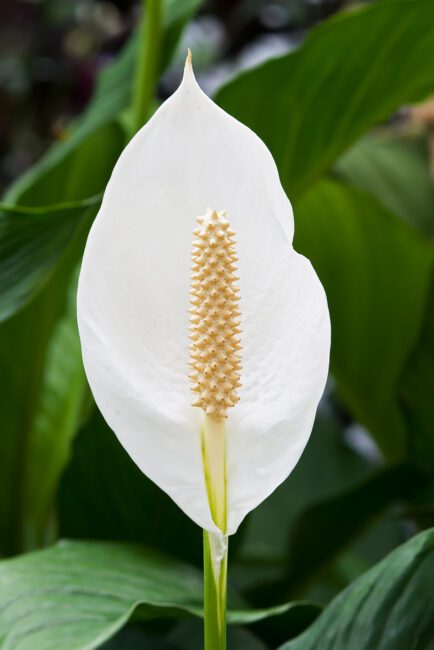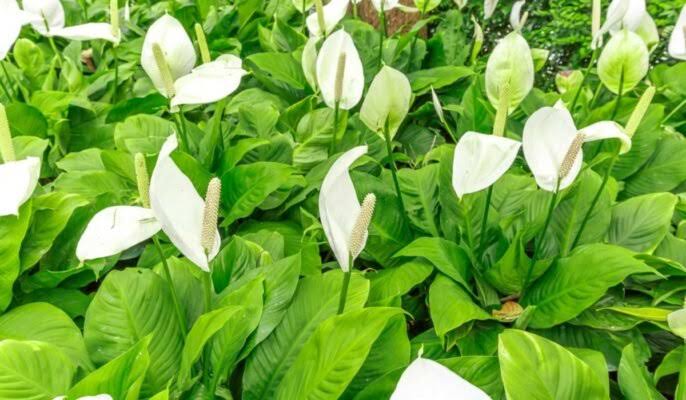Spathiphyllum, commonly known as Peace Lily, is a captivating and graceful plant that has won the hearts of plant enthusiasts worldwide. With its lush, dark green leaves and enchanting white flowers, this tropical beauty adds a touch of elegance to any space. Beyond its aesthetic appeal, the Spathiphyllum also boasts numerous benefits, making it a popular choice for both novice and seasoned plant lovers.
Originating from the tropical rainforests of Central and South America, the Spathiphyllum belongs to the Araceae family and is known for its striking white blooms, which resemble a delicate flag of peace. This distinct characteristic has earned it the name “Peace Lily” and has further enhanced its popularity as a symbol of tranquility and serenity.
One of the standout features of the Spathiphyllum is its ability to thrive in low-light conditions, making it an ideal choice for indoor environments. Whether placed in an office, living room, or bedroom, this plant can adapt and flourish with minimal sunlight, bringing a refreshing touch of nature to any space.
Beyond its visual appeal, the Peace Lily is also known for its air-purifying qualities. The plant has been found to effectively remove harmful toxins such as formaldehyde, benzene, and carbon monoxide from the air, creating a healthier and more breathable environment. Its natural ability to cleanse the air makes it an excellent addition to homes and offices, particularly in urban areas where pollution levels can be high.
Caring for a Spathiphyllum is relatively straightforward, making it an excellent choice for beginners. This plant prefers moist soil, but it’s important not to overwater it as excessive moisture can lead to root rot. Regular watering, allowing the soil to dry slightly between waterings, is usually sufficient to keep the Peace Lily thriving. Additionally, misting the leaves occasionally or placing the plant in a humid location helps replicate its native rainforest environment.
Pruning and grooming the Peace Lily are also essential to maintain its elegant appearance. Trimming yellow or brown leaves and spent flowers not only keeps the plant looking neat but also encourages new growth and flower production. As the Spathiphyllum matures, it may produce offshoots or “pups” that can be carefully separated and propagated into new plants, allowing you to expand your collection or share the beauty of this plant with others.
In terms of symbolism, the Spathiphyllum carries a significant message. As its common name suggests, the Peace Lily represents peace, purity, and harmony. It serves as a thoughtful gift for various occasions, expressing good wishes and a sense of calmness to its recipient.
Additionally, Spathiphyllum, or the Peace Lily, is an exquisite plant that combines visual allure, air-purifying properties, and symbolism into a single package. Its resilience, adaptability, and low-maintenance nature make it a popular choice for indoor gardening enthusiasts, providing both aesthetic and practical benefits. Whether you’re seeking to enhance the ambiance of your living space, improve air quality, or convey a message of peace, the Spathiphyllum is a delightful choice that will bring beauty and tranquility to your surroundings.
Read Also: The Different Crop Storage Methods
History And Significance of Spathiphyllum Flower

The history of Spathiphyllum dates back to the late 19th century when it was discovered and classified by German botanist Gustav Wallis. The name “Spathiphyllum” is derived from the Greek words “spathes,” meaning spathe or bract, and “phyllum,” meaning leaf, referring to the plant’s characteristic white bracts that resemble a hooded leaf.
Native to the tropical regions of Central and South America, Spathiphyllum species were initially found in rainforests, where they thrived in the shaded understory. It wasn’t until the late 19th and early 20th centuries that the plant gained popularity as an indoor ornamental plant in Europe and North America. Its attractive foliage and elegant flowers captured the attention of horticulturists and plant collectors, leading to its widespread cultivation as a houseplant.
The significance of Spathiphyllum goes beyond its aesthetic appeal. Throughout history, plants have held cultural and symbolic significance in various societies. Similarly, Spathiphyllum has acquired symbolic meanings in different cultures across the world.
One of the most common symbolic interpretations associated with Spathiphyllum is peace and tranquility. This symbolism is deeply rooted in its common name, Peace Lily. The white flowers are believed to represent purity, innocence, and the desire for peace. Because of this symbolism, the Peace Lily has become a popular choice for floral arrangements in times of mourning, as well as a gift to convey sympathy and condolences.
In addition to its symbolism of peace, the Spathiphyllum holds significance in Feng Shui, the ancient Chinese practice of harmonizing energy in living spaces. According to Feng Shui principles, the Spathiphyllum is considered an auspicious plant that attracts positive energy and promotes balance and harmony in the environment. It is believed to have a calming effect and is often placed in areas associated with rest, meditation, and contemplation.
However, the Spathiphyllum’s air-purifying qualities have garnered significant attention in recent years. NASA’s Clean Air Study identified the Peace Lily as an effective plant in removing toxins from indoor environments. Its ability to filter formaldehyde, benzene, and other harmful chemicals from the air contributes to healthier living spaces and has made it a popular choice for those seeking natural solutions to improve indoor air quality.
From its discovery in the rainforests to its global popularity as a beloved houseplant, the Spathiphyllum has become an icon of beauty, tranquility, and purity. Whether appreciated for its elegance, cherished as a symbol of peace, or valued for its air-purifying properties, this remarkable plant continues to captivate people’s hearts and enhance their surroundings with its timeless appeal and significance.
Read Also: Economic Importance, Uses, and By-Products of Grape Internodes
Complete Growing Guide For Spathiphyllum Flower

Growing a Spathiphyllum, or Peace Lily, can be a rewarding experience. Here are some guidelines to help you successfully cultivate and care for this beautiful plant:
1. Lighting:
Place your Peace Lily in a location with bright, indirect light. Avoid direct sunlight as it can scorch the leaves. A north or east-facing window is ideal.
While Peace Lilies can tolerate low light conditions, they will bloom more profusely with brighter light.
2. Temperature and Humidity:
Spathiphyllum prefers temperatures between 65-85°F (18-29°C). Avoid exposing the plant to extreme temperature fluctuations.
These plants thrive in high humidity environments, similar to their native rainforest habitat. If your home is dry, you can increase humidity by placing the plant on a tray filled with water and pebbles or using a room humidifier.
3. Watering:
Keep the soil evenly moist, but not soggy. Overwatering can lead to root rot.
Water your Peace Lily when the top inch (2.5 cm) of soil feels dry to the touch. Use room temperature water and allow any excess water to drain away.
Avoid letting the plant sit in standing water, as it can lead to root problems.
4. Soil:
Use a well-draining potting mix that retains some moisture, such as a blend of peat moss, perlite, and vermiculite.
A slightly acidic to neutral pH range is suitable for Peace Lilies.
5. Fertilization:
Feed your Spathiphyllum with a balanced, water-soluble fertilizer during the growing season (spring and summer). Follow the package instructions for dosage and frequency.
Avoid over-fertilizing, as it can result in burnt roots. Always dilute the fertilizer to half-strength or as recommended.
6. Repotting:
Repot your Peace Lily when it becomes root-bound, usually every 1-2 years. Spring is an ideal time for repotting.
Select a slightly larger pot and use fresh potting mix.
Gently loosen the roots and place the plant in the new pot at the same depth as before. Fill with soil and water thoroughly.
7. Pruning and Maintenance:
Remove yellow or brown leaves promptly to maintain the plant’s appearance.
Trim spent flowers to encourage new blooms and prevent seed production.
Wipe the leaves occasionally with a damp cloth to remove dust and improve the plant’s ability to photosynthesize.
8. Propagation:
Spathiphyllum can be propagated through division during repotting. Carefully separate the plant into smaller clumps, ensuring each section has roots attached.
Plant the divisions in separate pots with fresh potting mix and provide them with the same care as mature plants.
By following these guidelines and providing consistent care, you can enjoy the graceful beauty of the Spathiphyllum as it grows and thrives in your home or garden. Remember, each plant has unique needs, so observe your Peace Lily closely and make adjustments accordingly to ensure its well-being.
Uses of Spathiphyllum Flower
1. Ornamental Plant: The primary use of Spathiphyllum is as an ornamental plant. Its lush, dark green foliage and elegant white flowers make it a popular choice for indoor and outdoor gardens, as well as for floral arrangements. The Peace Lily adds a touch of beauty and grace to any space, enhancing the aesthetic appeal of homes, offices, and public spaces.
2. Air Purification: Spathiphyllum is renowned for its air-purifying properties. It has been scientifically proven to effectively remove toxins such as formaldehyde, benzene, and carbon monoxide from the air, making it an excellent choice for improving indoor air quality. By placing Peace Lilies in living spaces, offices, or areas with poor ventilation, you can enjoy cleaner and healthier air.
3. Gift and Symbolism: The Peace Lily holds symbolic meanings that make it a popular gift for various occasions. It is often given as a gesture of sympathy and condolences, representing peace, purity, and innocence. The plant’s graceful appearance and its association with tranquility make it a thoughtful present for birthdays, housewarmings, or any event where you want to convey a sense of peace and harmony.
4. Feng Shui: In Feng Shui, the Peace Lily is considered a symbol of harmony and positive energy. It is believed to attract good fortune and create a peaceful and balanced atmosphere in living spaces. Placing a Spathiphyllum plant in areas associated with relaxation, meditation, or family gatherings can promote a sense of tranquility and well-being.
5. Healing Environments: Spathiphyllum is often used in hospitals, clinics, and other healthcare settings due to its calming and soothing qualities. The plant’s presence has been found to reduce stress, enhance mood, and create a healing environment for patients. The Peace Lily’s ability to thrive in low-light conditions also makes it suitable for brightening up spaces with limited natural sunlight.
6. Educational and Research Purposes: Spathiphyllum is widely studied and used in botanical research and education. Its unique characteristics, growth patterns, and adaptations to different environments make it an interesting subject for plant enthusiasts, researchers, and students studying botany, horticulture, and related fields.
7. Herbal and Traditional Medicine: While Spathiphyllum is primarily grown for ornamental purposes, some traditional medicinal practices attribute healing properties to certain parts of the plant. However, it is essential to note that the Peace Lily is not commonly used in mainstream herbal medicine, and any medical applications should be researched and validated by experts.
However, Spathiphyllum, or the Peace Lily, offers numerous uses and benefits. Whether appreciated for its beauty, air-purifying capabilities, symbolism, or contribution to a healing environment, this versatile plant has found its place in homes, offices, and various settings worldwide.
Read Also: What Kind Of Plastics Can Be Recycled?
